Public Art Proposal Display
Bayview Crossings
Alice Beasley
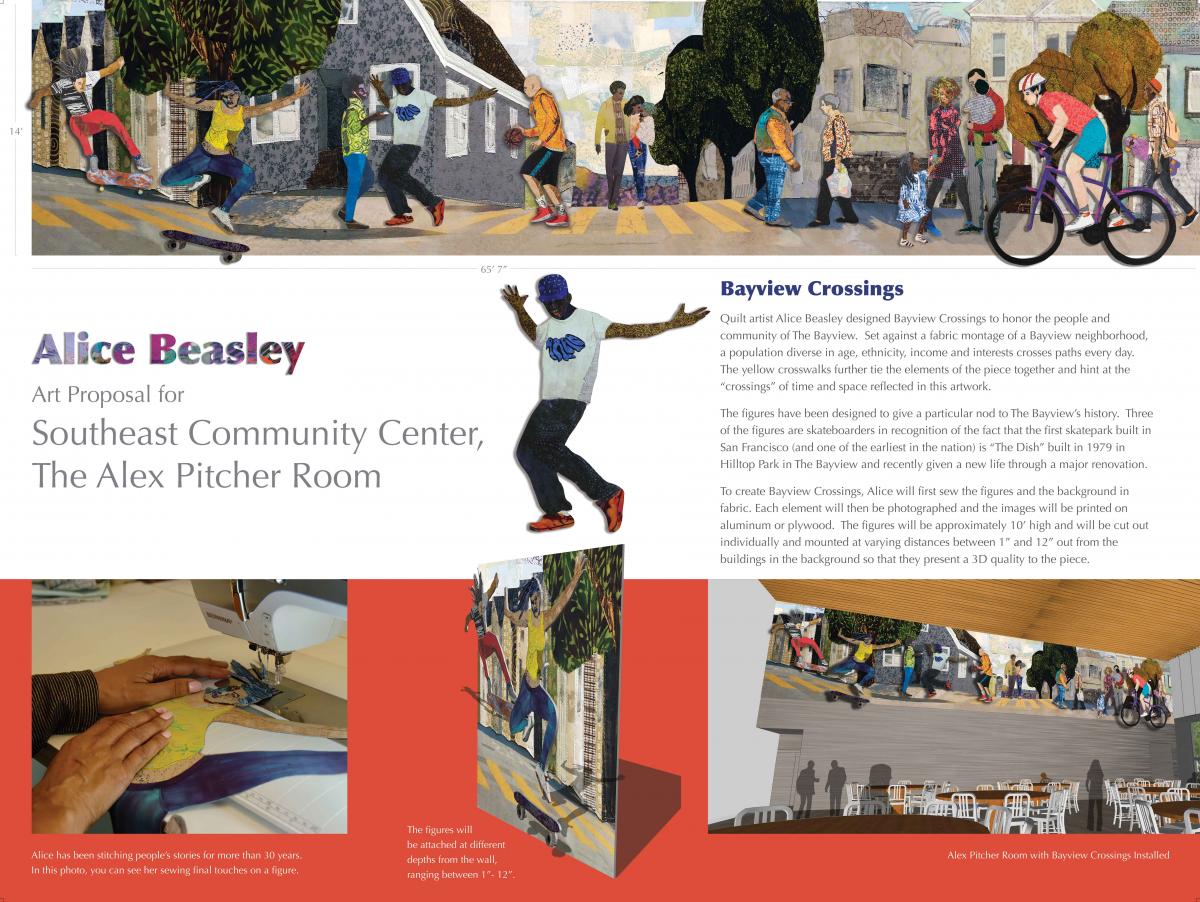 Bayview Crossings is designed to honor the people and community of The Bayview. Set against a fabric montage of typical housing stock for the area, a population diverse in age, ethnicity, income and interests crosses paths every day. The yellow crosswalks further tie the elements of the montage together and hint at the “crossings” of time and space reflected in this artwork. The piece has two components. The first is the background which would run the 65’ 7” length of the wall and would be approximately 14’ high. It would be sewn by the artist (at approximately 50% scale), then photographed and printed in panels on either a plywood or aluminum substrate by subcontractors. The second component is the figures presented as a cross-section of The Bayview population. These figures, also constructed in fabric by the artist at approximately 50% scale, will be photographed, printed and individually cut out from a substrate of either plywood or aluminum. If plywood is used, the edges of the figures would be beveled and painted black. The high gloss of the figures will contrast with a more subdued matte of the background. In contrast to the background, the figures will be sewn in high key colors.
Bayview Crossings is designed to honor the people and community of The Bayview. Set against a fabric montage of typical housing stock for the area, a population diverse in age, ethnicity, income and interests crosses paths every day. The yellow crosswalks further tie the elements of the montage together and hint at the “crossings” of time and space reflected in this artwork. The piece has two components. The first is the background which would run the 65’ 7” length of the wall and would be approximately 14’ high. It would be sewn by the artist (at approximately 50% scale), then photographed and printed in panels on either a plywood or aluminum substrate by subcontractors. The second component is the figures presented as a cross-section of The Bayview population. These figures, also constructed in fabric by the artist at approximately 50% scale, will be photographed, printed and individually cut out from a substrate of either plywood or aluminum. If plywood is used, the edges of the figures would be beveled and painted black. The high gloss of the figures will contrast with a more subdued matte of the background. In contrast to the background, the figures will be sewn in high key colors.
In the artwork as fabricated, the figures would be approximately 10 feet high. They would be mounted so as to project from the background at distances varying between 1 inch to 1 foot from the background (using appropriate armature) so that they present a 3D quality to the piece as installed.
The figures have been designed to give a particular nod to The Bayview’s history. Three of the figures represent skateboarders in recognition of the fact that the first skateboard park built in San Francisco (and one of the earliest in the nation) is “The Dish” built in 1979 in Hilltop Park in The Bayview and recently renovated under sponsorship by legendary Skater Tony Hawk, among others.
View a larger image of the proposal.
Doorway To A Dream
Louisiana Bendolph
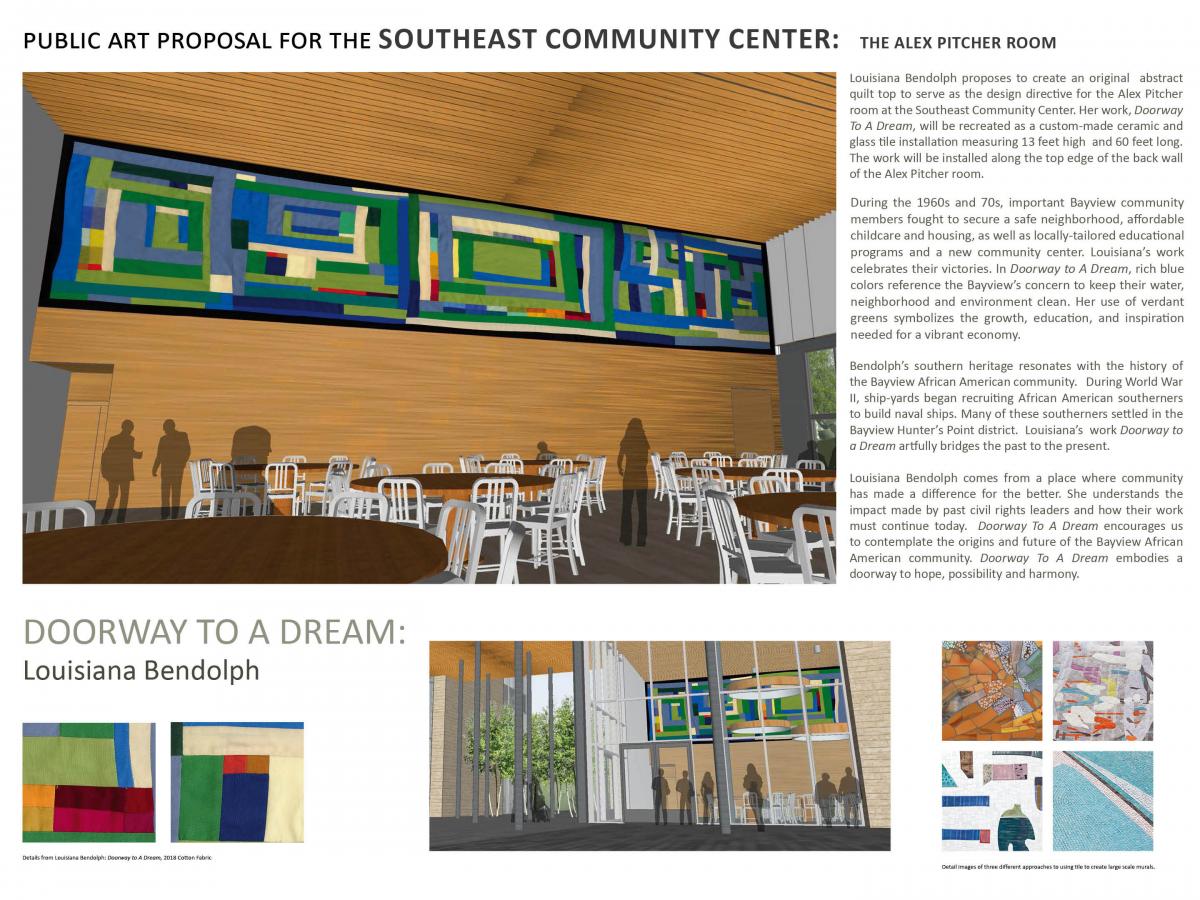 Louisiana Bendolph proposes to create an original abstract quilt top to serve as the design directive for the Alex Pitcher room at the Southeast Community Center. Her work, Doorway To A Dream, will be recreated as a custom-made ceramic and glass tile installation measuring 13 feet high and 60 feet long. The work will be installed along the top edge of the back wall of the Alex Pitcher room.
Louisiana Bendolph proposes to create an original abstract quilt top to serve as the design directive for the Alex Pitcher room at the Southeast Community Center. Her work, Doorway To A Dream, will be recreated as a custom-made ceramic and glass tile installation measuring 13 feet high and 60 feet long. The work will be installed along the top edge of the back wall of the Alex Pitcher room.
During the 1960s and 70s, important Bayview community members, fought to secure a safe neighborhood, affordable childcare and housing, as well as locally-tailored educational programs and a new community center. Louisiana’s work celebrates their victories. Their dedication to improving the community - while facing adversity from powerful governmental departments during the tumultuous civil rights years - led to important changes. They fought to secure a safe neighborhood, affordable childcare and housing, as well as locally-tailored educational programs and a new community center. In Bendolph’s Doorway to A Dream, rich blue colors reference the Bayview’s historic concern to keep their water, neighborhood and environment clean. Her use of verdant greens refers to the growth, education, and inspiration needed for a vibrant economy.
Louisiana Bendolph comes from a place where community has made a difference for the better. She understands the impact of past civil rights leaders and how their work must continue today. Bendolph’s Doorway to A Dream invites viewers to wander from tranquil architectural blocks of color to the surprise of small and energetic bursts of magenta, orange, and pink, all framed by a black border. Her colors and composition suggest a walk in a diverse and colorful community, where colorful surprises and discoveries are a common aspect of life.
Doorway to A Dream illustrates the improvisational style typical of her lineage with the quilters of Gee’s Bend. Uninhibited by the norms of fine art, the Bend quiltmakers have been guided by a faith in a personal vision. Most of them start with basic forms and head off “their way” with unexpected patterns, unusual color and surprising rhythms. The tradition of quilt making has been handed down from mother to daughter for generations, defining their community by their exquisite craft and artistry. Theirs are handsome, if unorthodox, works of art. By making what they want to make, these women reveal innovative ways of looking at fabric, design, and format, which is deeply founded in their history, culture and community.
Bendolph understands the importance of community and her work is a celebration of that belief. Doorway to a Dream pays homage to the strength of her community working together to create beauty, structure and stability. Echoing the benchmarks of what the famous “Big 5” accomplished for the Bayview community, Louisiana’s work speaks to the promise of continuing and celebrating those achievements.
View a larger image of the proposal.
Building A Better Bayview
Phillip Hua
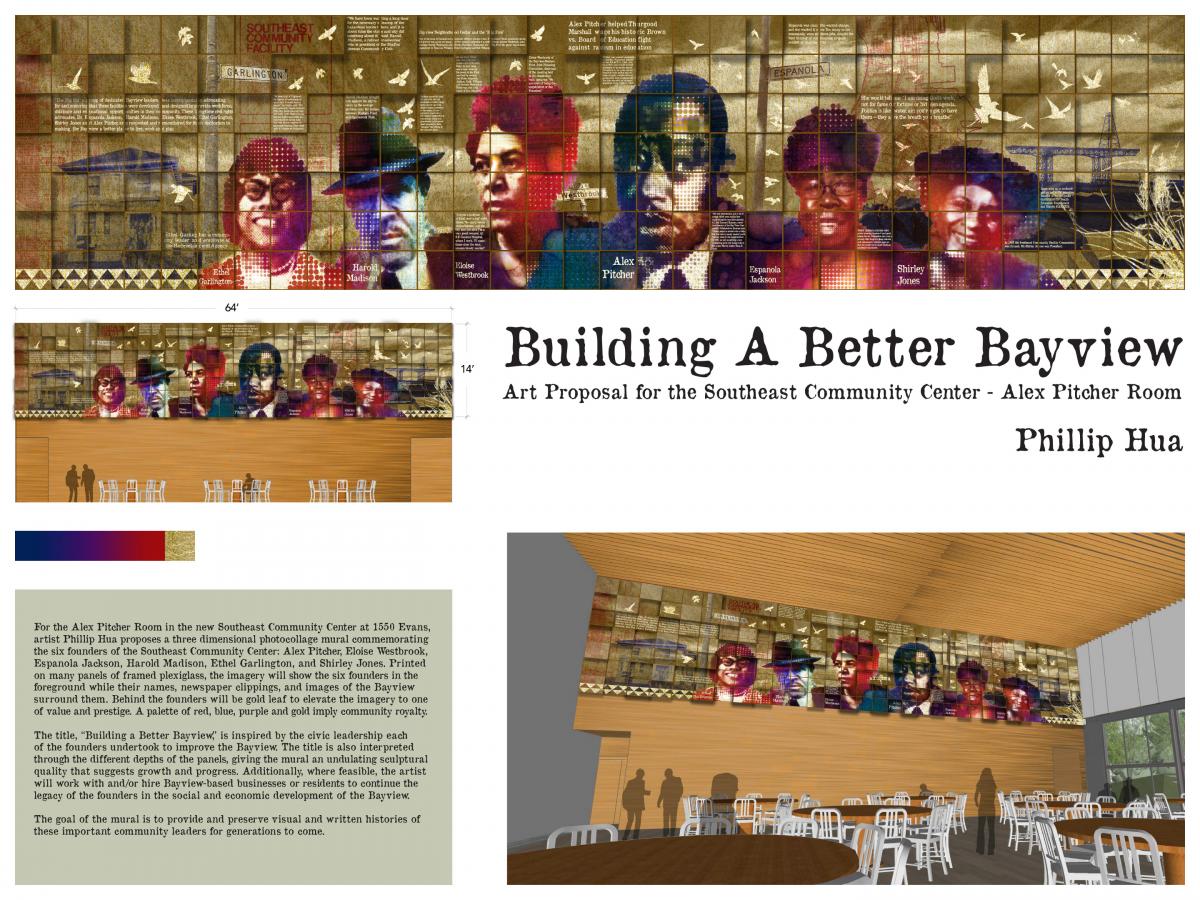 For the Alex Pitcher Room in the new Southeast Community Center at 1550 Evans, artist Phillip Hua proposes a three-dimensional photocollage mural commemorating the six founders of the Southeast Community Center: Alex Pitcher, Eloise Westbrook, Espanola Jackson, Harold Madison, Ethel Garlington, and Shirley Jones. The imagery will show the six founders in the foreground while their names, relevant newspaper and publication quotes, and images of the Bayview surround them. Included are drawings for the original Southeast Community Facility, an image of the Bayview Community Center (an historic site where community meetings were held), a map of the Bayview, and an image of the shipyard (the reason many African Americans came to San Francisco). Behind the founders will be gold leaf to elevate the imagery to one of value and prestige. The goal of the mural is to provide and preserve visual and written histories of these important community leaders for generations to come.
For the Alex Pitcher Room in the new Southeast Community Center at 1550 Evans, artist Phillip Hua proposes a three-dimensional photocollage mural commemorating the six founders of the Southeast Community Center: Alex Pitcher, Eloise Westbrook, Espanola Jackson, Harold Madison, Ethel Garlington, and Shirley Jones. The imagery will show the six founders in the foreground while their names, relevant newspaper and publication quotes, and images of the Bayview surround them. Included are drawings for the original Southeast Community Facility, an image of the Bayview Community Center (an historic site where community meetings were held), a map of the Bayview, and an image of the shipyard (the reason many African Americans came to San Francisco). Behind the founders will be gold leaf to elevate the imagery to one of value and prestige. The goal of the mural is to provide and preserve visual and written histories of these important community leaders for generations to come.
The title, “Building a Better Bayview,” is inspired by the civic leadership the founders undertook to improve the Bayview. Each of them made efforts to improve the quality of life in the Bayview and their portraits make their memory more tangible. The title is also interpreted through the different depths of the panels, giving the mural an undulating sculptural quality that suggests growth and progress. Additionally, where feasible, the artist will work with and/or hire Bayview-based businesses or residents to continue the legacy of the founders in the social and economic development of the Bayview. Photos of the founders will be procured from the families and community. Contacts for the families of four of the six founders have been identified and they will be involved in helping select the photo to be used in the final mural composition.
View a larger image of the proposal.
Untitled
Ronald M Saunders
 The images created for this proposal are inspired by the history and culture of Bayview Hunter’s Point. They were designed to embody the richness of the diverse individuals who have proudly made this community their home, and inspire future leaders to continue to be engaged with life in the Bayview.
The images created for this proposal are inspired by the history and culture of Bayview Hunter’s Point. They were designed to embody the richness of the diverse individuals who have proudly made this community their home, and inspire future leaders to continue to be engaged with life in the Bayview.
The first panel on the left represents a community of people from the Bayview. I have chosen Sam Jordan, the first African American man to run for mayor of San Francisco and was known as the Mayor of Butchertown. He was also a light heavyweight boxing champion. There are businesses like Sam Jordan’s Club and Mazzei Hardware that have been in Bayview for more than fifty years. The nets in the background reference the Chinese shrimp fishermen who had businesses in the area. As a resident of Bayview Hunter’s Point for more than 30 years, I continue to hear new stories about community members who had an impact in this area. This artwork is intended to create space for dialogue about the community’s past and present history.
The photographic images are created employing the photogram process. Photograms are photographs made without the use of a camera. This 19th century photographic process has an immediacy, and rawness and truth that are more primal than images created with a camera. I place the human figure, plant material and water separately on the surface of silver-based photographic paper, and then the paper is exposed to light emitted from an enlarger to create a shadowy silhouette image. A collage effect is achieved when I layer the objects on the surface of the photographic paper and make separate exposures of each element. The unique images are scanned and colorized using Photoshop to create digital cyanotypes.
The photograms will be reproduced on porcelain enamel, which is a mixture of mineral content glass and inorganic pigments fused to a steel substrate at temperatures exceeding 1400 degrees Fahrenheit. This extreme temperature literally melts and fuses the glass to the steel, forming a molecular bond and creating a permanent coating. Graphics are applied with glass-based inks by a variety of methods including traditional screen-printing, stenciling and a high-resolution photographic process. Each color is applied and fired one layer at a time, creating full color, high-resolution. The enamel surface resists scratching, graffiti is easily removed, and because of its inorganic base, porcelain enamel is naturally resistant to the harmful ultraviolet component of sunlight.
View a larger image of the proposal.
For more information,
Please contact: mary.chou@sfgov.org, or (415) 252-2233.
Materiales traducidos están disponibles para usted de manera gratuita. Para asistencia, notifique a mary.chou@sfgov.org, or (415) 252-2233.
我們將為閣下提供免費的書面翻譯資料。 如需協助,mary.chou@sfgov.org, or (415) 252-2233.
Ang mga materyales na nakasalin sa ibang wika at ang mga serbisyong tagapagsalin sa wika ay walang bayad. Para sa tulong, maaring i-contact si mary.chou@sfgov.org, or (415) 252-2233.
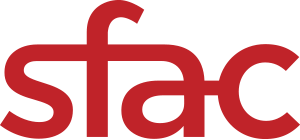
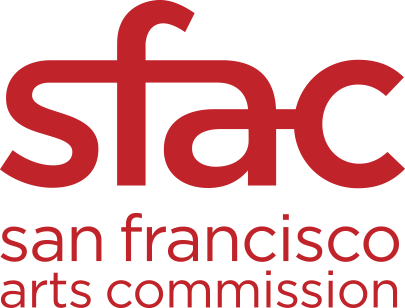

Opportunity For Public Comment
Please take a few minutes to review these artwork proposals and provide feedback on the public comment form below. Public comments will be considered by the Selection Panel as part of the Final Selection Panel meeting where the Panel will recommend one proposal for implementation. Please note that public comments do not constitute a vote.
The Final Selection Panel meeting will take place Friday, November 2, 2018, 9 a.m.–4:00 p.m. at 401 Van Ness Avenue, Room 302. All Artist Selection Panel meetings are open to the public. An agenda for the meeting will be posted 72 hours in advance of the meeting on SFAC’s website under the Public Meeting section: www.sfartscommission.org.
The proposals are available online at www.sfartscommission.org/calendar, in the Public Art Proposal Display section. Comments may be emailed to sfacpublicartcomment@sfgov.org, or hand delivered/mailed to 401 Van Ness Avenue, Room 325 by Wednesday, October 31, 2018 at 5:00 p.m.